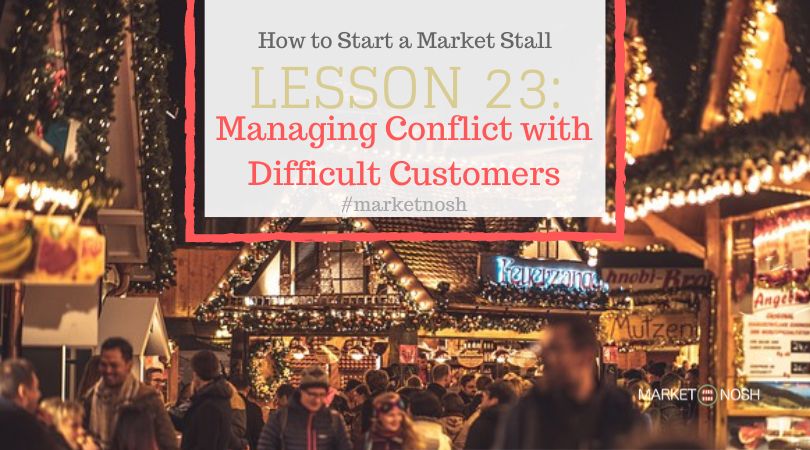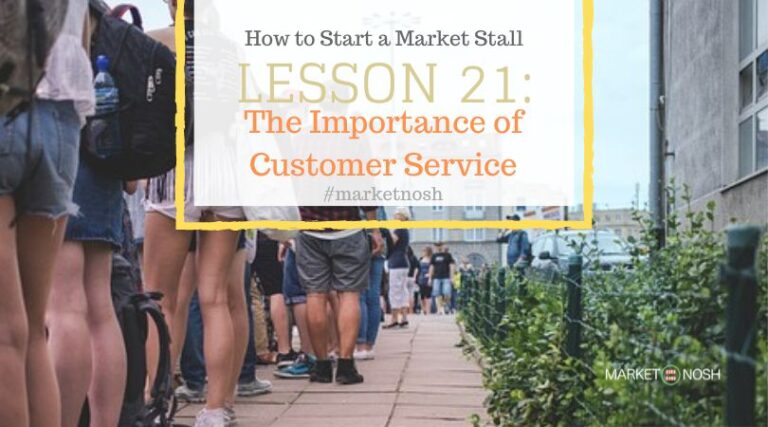Lesson 23: Managing Conflict with Difficult Customers – A Guide for Market Stall Holders
Conflict happens. It is as simple as that.
Knowing how to approach and deal with complaints and disagreements is key to having a positive experience in the Market Place and can really elevate your brand to higher levels too.
As a stall holder, effectively resolving conflicts with difficult customers is not just about maintaining peace—it’s about preserving your reputation, fostering customer loyalty, and ensuring a positive experience for all.
In this comprehensive guide, we’ll explore common sources of conflict, strategies for de-escalation, and practical tips to turn challenging situations into opportunities for customer satisfaction and growth.
Understanding Conflict in the Marketplace
Conflict can arise from various sources, including misunderstandings, dissatisfaction with products or services, communication barriers, or external factors like weather or crowded conditions.
Customers may express their frustrations through verbal complaints, aggressive behavior, or negative body language. As a stall holder, it’s essential to approach each situation with empathy, patience, and a willingness to find mutually beneficial solutions.
At all times, keep in mind there is a misunderstanding. That way you can deflect taking a comment or inference personally and then reacting from an emotional state. If you are able to detach the problem from your emotion connection you will be better able to deal with customers who have complaints.
Let’s look at ways to resolve conflict effectively.
1. Stay Calm and Listen Actively
When confronted with a difficult customer, maintain a calm demeanour and avoid reacting defensively. Listen attentively to their concerns without interrupting, acknowledging their emotions and validating their experience.
You have the power to control your emotions and reactions. Hear first what the issues are.
For example, a customer complains about the freshness of bread purchased from your stall. Instead of becoming defensive, listen actively to understand their specific concerns about the product’s quality and taste.
It may be a real concern they are offering, and your reputation is now on the line. Did. something happen to that one loaf, or has something gone wrong in the packing process.
Stall holders don’t need to be wrong, but it is important to understand what the issue is first and try to understand the situation clearly to be able to offer the best solution possible.


2. Empathise and Apologise
Acknowledging a person has a complaint is half the battle. There has clearly been a misunderstanding somewhere.
Demonstrate empathy by expressing understanding of the customer’s feelings and apologising for any inconvenience caused, regardless of fault.
Try saying, “I’m sorry to hear you’re not satisfied with the bread. I understand how disappointing it can be when products don’t meet expectations.”
This way you are recognising the person and the complaint first. Be sincere at this point, it is your reputation and your product that is being judged, and like anyone who cares about their children, so you care about your products and the ay others perceive you.
3. Clarify and Gather Information
When someone is unhappy it is important to establish what has happened to cause this confrontation. Be careful to not just leap to a conclusion first. Ask clarifying questions to pinpoint the root cause of the issue and gather necessary details to resolve it effectively.
This way you are hearing what the customer is unhappy with and you can be better able to resolve the issue, rather than to make your mind up it is one thing and the customer is saying something else.
Try politely inquiring, “Could you please tell me more about what you found unsatisfactory? Is it the taste, texture, or something else?”
When you listen, you’ll be able to address the concerns rather than what you think are the concerns. Much of any disagreement is a misunderstanding of what was presented and what was received.


4. Offer Solutions and Options
Address every confrontation with a solutions-orientated mindset. You’ll be better prepared to propose practical solutions or alternatives that address the customer’s concerns and demonstrate your commitment to resolving the issue.
We are still at the bakery and it is far easier to offer a replacement loaf of bread and/or refund, and assure the customer that you will address the quality concern, than to argue over one loaf.
It is good to ask the customer how they would like the complaint resolved. You may be surprised at how a customer responds. Often it may even provide you with an insight on how to improve into the future too.
Picture the hours someone may work for their money and then the expectation of using that money to purchase something which does not live up to that expectation. No different to yourself at the Market Stall earning your money only to have something your paid for not live up to the expectation.
5. Take Responsibility and Follow Through
No is your time to shine. Take responsibility for resolving the conflict promptly and follow through on any promises made to the customer.
Often the way you handle a complaint is more telling than the way you deal with customers. It is about care for the people you are dealing with and that care extends to your products and services.
Imagine your response to a complaint about stale bread with, “I’ll replace the bread for you right away, and I’ll ensure we maintain our usual quality standards.”
It is easy to sort an issue out once you know what the problem is. the difficult part often is finding a process that you use to be failing and a complaint highlights that for you.
This is an opportunity to find ways to improve to avoid future conflicts.

Practical Tips for Conflict Resolution
- Train Yourself and Staff:
– Provide training on effective communication, conflict resolution techniques, and customer service skills. Equip them with strategies to handle challenging situations professionally. - Set Clear Policies:
– Establish clear policies regarding refunds, exchanges, and customer complaints. Communicate these policies clearly to customers to manage expectations and avoid misunderstandings. - Maintain Professionalism:
– Maintain a professional demeanour at all times, even in stressful situations. Avoid arguing with customers or taking their complaints personally. - Document Incidents:
– Keep records of customer complaints, resolutions, and feedback. Use this information to identify recurring issues and implement preventive measures. - Seek Feedback:
– Encourage customers to provide feedback on their experience at your stall. Use their input to continuously improve your products and services.
Turning Challenges into Opportunities
Successfully resolving conflicts with difficult customers not only diffuses immediate tensions but also builds trust, enhances your reputation, and fosters customer loyalty.
By implementing proactive strategies and maintaining a customer-centric approach, market stall holders can transform challenging interactions into opportunities for growth and positive word-of-mouth.
Remember you are on stage. Others are watching how you react all around you, so be measured in your responses and try your best to work with customers rather than against them.
It is perfectly acceptable to point out a misunderstanding or even something which is an untruth, but do it with a tone which take into account the misunderstanding. Help the customer to see what has occured and assist in getting things back on track.
No one likes buying something and then having a fight over it. That item represents a bad feeling and will be discarded shortly afterwards, but image the feeling of something which resulted in positive feeling, a sense of care and an acknowledgement of the human inside us all.

Conclusion
In conclusion, conflict resolution is a crucial skill for market stall holders to master in their daily interactions with customers.
By approaching conflicts with empathy, active listening, and solution-oriented strategies, stall holders can effectively address customer concerns, preserve relationships, and create a welcoming atmosphere at their stalls.
Remember, every conflict resolved is an opportunity to strengthen your business and leave a lasting positive impression on your customers. With these practical tips and a commitment to customer satisfaction, you can navigate conflicts with confidence and continue to thrive in the vibrant marketplace environment.
We would love to learn what some of the conflicts you have had and how you managed to resolve them. Let us know over on Facebook.
Quick Quiz
- Why is it important to act in a professional way when resolving a conflict?
- How does Empathising work to assure the customer you are listening?
- Why is it important to clarify what the issue is before making certain judgements?








